Sold Ceramics
Sold Japanese Imari 1690-1800
Dishes
Page 1
When internal wars began to impede the production of, and consequently the trade in, Chinese porcelain toward the end of the Ming Dynasty (1368-1644), several Dutch Merchants began to buy porcelain in Japan. At the same time, the production of faience pottery in Delft was stimulated, in order to compensate the shortage of Chinese porcelain. From 1658 onward, the Dutch East India Company, (Vereenigde Oost-Indische Compagnie, VOC) also recognized these commercial opportunities and began to order greater quantities of porcelain from Japan. In addition to a very diverse assortment of blue-and-white porcelain. largely in the style of traditional Chinese export goods, the coloured Japanese porcelain formed an unexpected new article in the Netherlands. It soon became very fashionable and the Company was able to generate a great deal of profit in this field.
One potter who benefited greatly from the new Dutch orders was Sakaida Kakiemon, who owned a porcelain kiln near Nangawara, just outside Arita. His porcelains characterized by a lucid whit composition and texture with decorations in various tints of enamel including orange-red, grass-green and blue.
By the second half of the 17th century, this porcelain had already seen the rise of a serious rival, the so-called Imari porcelain, named after the port in Kyushu from which it was shipped. This Imari was cheaper, and had vibrant, full decoration in cobalt blue, orange-red and gold, occasionally with extra details in green enamel, aubergine or black. It was manufactured specifically for export and harmonized perfectly with the baroque taste of the buyers in the Netherlands. It became so popular that the Chinese also began to produce it from the 18th century onward.

Sold Ceramics - Sold Japanese Imari 1690-1800 - Dishes - Page 1
Object 2011490 and 2011491
Two dishes
Japan
1670-1690
2011491: height 50 mm (1.97 inch), diameter 330 mm (12.99 inch), diameter of footring 170 mm (6.69 inch), weight 1.205 grams (42.51 ounce (oz.))
2011490: height 50 mm (1.97 inch), diameter 337 mm (12.99 inch), diameter of footring 165 mm (6.69 inch), weight 1.018 grams (35.91 ounce (oz.))
Two dishes on footrings, flat rims. On the base of dish 2011490 four spur-marks and on the base of dish 2011491 five spur-marks in a X-pattern. Both decorated in underglaze blue and enamels with in the centre a flowerpot surrounded by a band of a continuous branch of prunus blossoms. The sides and rims are divided into kraak-style panels, the large panels filled with flowering plants, the narrow ones with geometric patterns. The reverses have a continuous flower scroll in red, green and yellow. On the base of dish 2011490 an old rectangular paper label that reads: 'Papa = acheté la paire à Bruxelles en 1957 à 2.500 F. (en face de Lips)' which translates as 'Dad bought the pair in 1957 for 2.500 F. (across from Lips)'
Jörg describes an identical dish in his Fine & Curious. Japanese Export Porcelain in Dutch Collections. This rare dish can be considered an interesting intermediate piece. It combines the underglaze blue kraak-style (fuyō-de) with early Imari enamelling. (Arts 1983, p.48 plate 19a), (Jörg 2003/1, p.94, cat. 87 & p.291)
For an identically shaped, sized and decorated dish, please see;
- Fine & Curious: Japanese Export Porcelain in Dutch Collections, (C.J.A. Jörg, Hotei publishing, Amsterdam, 2003), p.94, cat. 87.
- Collection Groninger Museum.
For an example of an early, underglaze blue, Japanese kraak dish, dated 1660-1680, please see: Ayers, Impey & Mallet 1990, p.93 cat. 31.
Dish 2011490 shows a finely crackled greyish glaze that can be compared with that of a group of dishes in early Kakiemon style of the same period as this dish. This demonstrates a typical feature of Japanese porcelain, where the glaze is often but not always crackled. Dish 2011491, which originally formed a pair with dish 2011490 (see the rectangular paper label on the base) does not have the crackled glaze, which underlines that both was possible with Japanese porcelain and both were considered of equal quality. (Jörg 2003/1, pp.75-76, cat. 62 & 63)
The colour scheme of the scrolls on the reverses and the ‘light’ way of painting the leaves and flowers is still reminiscent of the early enamelled pieces. At the same time, the dense design, combination of underglaze blue with enamels and the bands in the centres already shows the early stages of the mature Imari style, which developed somewhere between 1670-1690. This was in all likelyhood stimulated by the orders from the Dutch who liked the bright colours, strong designs and complex compositions. (Jörg 2003/1, p.91)
Another hybrid style dish which offers an interesting comparison can be found in the collection of the Royal Trust (inv. nr. RCIN 58828). The underglaze blue kraak design still clearly prevails here. The enamels show an opaque, strong green and dark brick-red, which resembles the early enamels colour scheme more closely. Therefore, this piece can probably be dated slightly earlier than our dish(es).
Finally, this unusual Imari design can also be found on a finely painted copy, possibly of 19th or 20th century Japanese origin, featuring the same diameter, please see: Windsor House Antiques (Ref No. 6522). The dish also has spur-marks and an unidentified (pseudo?) mark on the back. The high quality of this dish is striking. Perhaps it was made to replace an original Japanese dish as part of a larger set?
Windsor House Antiques (Ref No. 6522), this dish is not included in this sale/offer.
Condition:
2011490: Fine crackled glaze and a hairline to the rim.
2011491: A chip to the rim.
References:
Ayers, Impey & Mallet 1990, cat. 31
Jörg 2003/1, cat. 62, 63 & 87, p.91 & p.291
www.royalcollection.org.uk/, inv. nr. RCIN 58828
www.windsorhouseantiques.co.uk/, Ref No. 6522
Price:
2011490: Sold.
2011491: Sold.
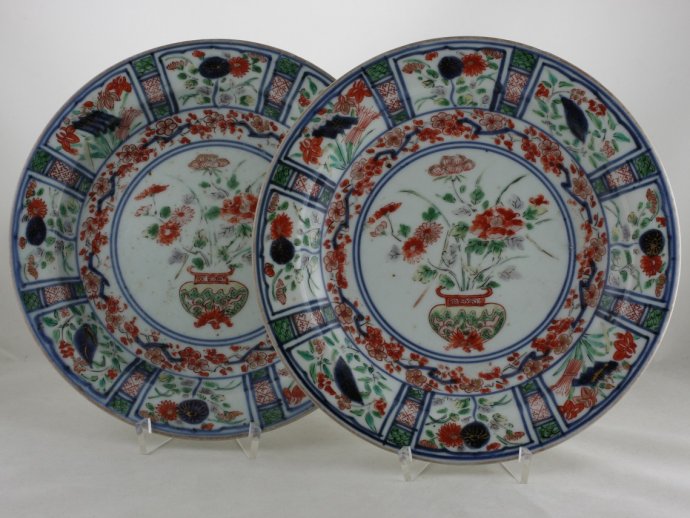
Sold Ceramics - Sold Japanese Imari 1690-1800 - Dishes - Page 1
Objects 2012462 & 2012463
Two dishes
Japan
1670-1690
2012462: height 31 mm (1.22 inch), diameter 218 mm (8.58 inch), diameter of footring 115 mm (4.53 inch), weight 403 grams (14.21 ounce (oz.))
2012463: height 33 mm (1.30 inch), diameter 218 mm (8.58 inch), diameter of footring 114 mm (4.49 inch), weight 394 grams (13.90 ounce (oz.))
Two dishes on footrings, flat rims. On the base of dish 2012462 three spur-marks in a V-pattern and on the base of dish 2012463 four spur-marks in a Y-pattern. Both decorated in underglaze blue and enamels with in the centre a flowerpot surrounded by a band of a continuous branch of prunus blossoms. The sides and rims are divided into kraak-style panels, the large panels filled with flowering plants, the narrow ones with geometric patterns. The reverses have a continuous flower scroll in red, green and yellow.
Jörg describes an identical larger dish in his Fine & Curious. Japanese Export Porcelain in Dutch Collections. This rare dish can be considered an interesting intermediate piece. It combines the underglaze blue kraak-style (fuyō-de) with early Imari enamelling. (Arts 1983, p.48 plate 19a), (Jörg 2003/1, p.94, cat. 87 & p.291)
The colour scheme of the scrolls on the reverses and the ‘light’ way of painting the leaves and flowers is still reminiscent of the early enamelled pieces. At the same time, the dense design, combination of underglaze blue with enamels and the bands in the centres already shows the early stages of the mature Imari style, which developed somewhere between 1670-1690. This was in all likelyhood stimulated by the orders from the Dutch who liked the bright colours, strong designs and complex compositions. (Jörg 2003/1, p.91)
For identically shaped, sized and decorated dishes, please see;
-
Sold Ceramics - Sold Japanese Imari 1690-1800 - Dishes - Page 1 - Object 2011490.
-
Sold Ceramics - Sold Japanese Imari 1690-1800 - Dishes - Page 1 - Object 2011491.
- Fine & Curious: Japanese Export Porcelain in Dutch Collections, (C.J.A. Jörg, Hotei publishing, Amsterdam, 2003), p.94, cat. 87.
- Collection Groninger Museum.
For an example of an early, underglaze blue, Japanese kraak dish, dated 1660-1680, please see: Ayers, Impey & Mallet 1990, p.93 cat. 31.
Another hybrid style dish which offers an interesting comparison can be found in the collection of the Royal Trust (inv. nr. RCIN 58828). The underglaze blue kraak design still clearly prevails here. The enamels show an opaque, strong green and dark brick-red, which resembles the early enamels colour scheme more closely. Therefore, this piece can probably be dated slightly earlier than our dish(es).
Finally, this unusual Imari design can also be found on a finely painted copy, possibly of 19th or 20th century Japanese origin, featuring the same diameter, please see: Windsor House Antiques (Ref No. 6522). The dish also has spur-marks and an unidentified (pseudo?) mark on the back. The high quality of this dish is striking. Perhaps it was made to replace an original Japanese dish as part of a larger set?
Windsor House Antiques (Ref No. 6522), this dish is not included in this sale/offer.
Condition:
2012462 Perfect.
2012463: A firing flaw to the reverse rim and to the footring.
References:
Ayers, Impey & Mallet 1990, cat. 31
Jörg 2003/1, cat. 62, 63 & 87, p.91 & p.291
www.royalcollection.org.uk/, inv. nr. RCIN 58828
www.windsorhouseantiques.co.uk/, Ref No. 6522
Price:
2012462: Sold.
2012463: Sold.

Sold Ceramics - Sold Japanese Imari 1690-1800 - Dishes - Page 1
Object 2012542
Dish
Japan
1690-1710
Height 41 mm (1.61 inch), diameter of rim 325 mm (12.80 inch), diameter of footring 175 mm (6.89 inch), weight 1,247 grams (43.99 ounce (oz.))
Dish on footring, wide flat rim with a slightly upturned edge. On the base four spur-marks in a Y-pattern. Imari, decorated in underglaze blue and overglaze iron-red, green, turquoise, yellow, grey, and black enamel and gold with a large flowering peony spray surrounded by flower heads and lotus buds on a wide arabesque scroll in underglaze blue outlined in gold. On the rim a continuous foliate and peony scroll with flower buds and flower heads. On the reverse three widespread flower sprays and round the foot a band with upturned spiky lotus leaves.
It's rather special in that the flat shape of this dish clearly reflects the model that was used by the Chinese potter, namely a Dutch pewter plate. The decoration on this dish is of the early (1690-1710) Japanese Imari type with the use of translucent green, turquoise, yellow, grey, and black enamel.
(reproduced from: Mistrovská dĩla Japonského porcelánu / Masterpieces of Japanese Porcelain, (F. Suchomel, Prague 1997), p.145, cat. 198, not included in this sale/offer)
For an identically shaped, sized and similarly decorated dish, please see;
Condition: Some loss of enamel.
Reference:
Price: Sold.
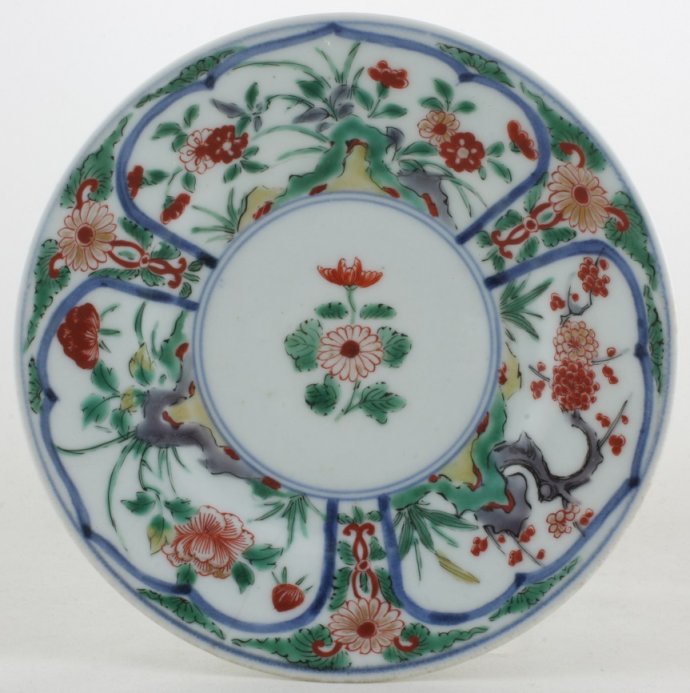
Sold Ceramics - Sold Japanese Imari 1690-1800 - Dishes - Page 1
Object 2012647
Small dish
Japan
1670-1690
Height 22 mm (0.86 inch), diameter 155 mm (6.10 inch), diameter of footring 65 mm (2.56 inch), weight 161 grams (5.68 ounce (oz.))
Small dish on footring, broad flat rim. On the base a single spur-mark, Decorated in underglaze blue and enamels within the centre a chrysanthemum flower spray in a double concentric band in underglaze blue. The sides and rims are divided into Chinese kraak-style panels filled with flowering plants, in between the panel's chrysanthemum flowerheads with leafy branches. The reverse with three widespread flowering peony plants growing from rockwork round the foot a double concentric band in underglaze blue.
The shape of this small dish is interesting, originally it probably came with a covered bowl that is now lost. These type of small (under) dishes with the broad flat rim and early Imari decoration are rare. The predominant use of green enamel feeds the thought that the decorators copied Chinese famille verte wares from that period as well as the use of the Chinese kraak style panelled border. Considering the early dating (1670-1690) of this small dish it could very well have been made and painted by a generation of Chinese potters and decorators, or immediate pupils trained by them working at that time at Japanese kiln sites.
Jörg describes a similarly decorated dish in his Fine & Curious. Japanese Export Porcelain in Dutch Collections. This rare dish can be considered an interesting intermediate piece. It combines the underglaze blue kraak-style (fuyō-de) with early Imari enamelling. (Arts 1983, p.48 plate 19a), (Jörg 2003/1, p.94, cat. 87 & p.291)
For similarly decorated intermediate objects (positioned between early enamel and later traditional Imari), please see.
- Fine & Curious: Japanese Export Porcelain in Dutch Collections, (C.J.A. Jörg, Hotei publishing, Amsterdam, 2003), p.94, cat. 87.
-
Sold Ceramics - Sold Japanese Imari 1690-1800 - Dishes - Page 1 - Object 2011490.
-
Sold Ceramics - Sold Japanese Imari 1690-1800 - Dishes - Page 1 - Objects 2012462.
- Collection Groninger Museum.
The dense design, combination of underglaze blue with enamels already shows the early stages of the mature Imari style, which developed somewhere between 1670-1690. This was in all likelyhood stimulated by the orders from the Dutch who liked the bright colours, strong designs, and complex compositions. (Jörg 2003/1, p.91)
Another hybrid style dish which offers an interesting comparison can be found in the collection of the Royal Trust (inv. nr. RCIN 58828). The underglaze blue kraak design still clearly prevails here. The enamels show an opaque, strong green and dark brick-red, which resembles the early enamels colour scheme more closely. Therefore, this piece can probably be dated slightly earlier than our dish(es).
Condition: A hairline to the rim.
References:
Jörg 2003/1, cat. 62, 63 & 87, p.91 & p.291
www.royalcollection.org.uk/, inv. nr. RCIN 58828
Price: Sold.

Sold Ceramics - Sold Japanese Imari 1690-1800 - Dishes - Page 1
Object 2012562
Dish
Japan
1690-1710
Height 42 mm (1.65 inch), diameter of rim 285 mm (11.22 inch), diameter of footring 148 mm (5.83 inch), weight 733 grams (25.86 ounce (oz.))
Twelve-sided dish on footring, flat rim with slightly upturned edge. Four spur-marks in a Y-pattern on the base. Imari, decorated in underglaze blue, iron-red, gold and black, gray, yellow and green enamel with a river scene with houses with various trees on a shore near rockwork on the left a waterfall with plants and rockwork and two carp trying to swim up the stream. On the horizon a mountain landscape with a pagoda trees and swirling clouds. Round the central design an aoi flower pattern border. On the sides two large panels filled with a wicker flowerpot on a low table filled with flowering peony or chrysanthemum plants on a golden ground alternating with a panel with a river scene with houses and trees and rockwork on a shore and on the horizon a mountain landscape with a pagoda trees and swirling clouds. All larger panels are divided by smaller panels with geometric patterns in gold on an underglaze blue ground. On the reverse a continuous widespread flowering peony scrolls. On the base a single chrysanthemum flowerhead in a double concentric band in underglaze blue.
The aoi flower decoration on the border round the central design can also be seen on the border round the central decoration of a large Imari decorated dish, dated (1690-1730), with similar vibrant enamel colours in the collection of the National Palace Museum, Taiwan (inv. nr.10100). For this dish see the exhibition catalogue 'Sailing the High Seas. A Special Exhibition of Imari Porcelain Wares' National Palace Museum Taiwan, object 168, page 288.
For an identically shaped, sized and decorated dish, please see;
- Complete Catalogue of the Shibata Collection, (The Kyushu Ceramic Museum, Kyushu 2003), p.355, cat. 2780.
- The Shibata Collection Part IV, (The Kyushu Ceramic Museum, Kyushu, 1995), p.49, cat. 60.
Condition: A firing flaw to the rim.
References:
Price: Sold.

Sold Ceramics - Sold Japanese Imari 1690-1800 - Dishes - Page 1
Objects 2012271 & 2012272
Two dishes
Japan
1700-1720
2012271: Height 41 mm (1.61 inch), diameter 255 mm (10.04 inch), diameter of footring 130 mm (5.12 inch), weight 671 grams (23.67 ounce (oz.))
2012272: Height 44 mm (1.73 inch), diameter 258 mm (10.16 inch), diameter of footring 130 mm (5.12 inch), weight 591 grams (20.85 ounce (oz.))
Two dishes on footrings, flat rims. On the bases three and four spur-marks. Imari, decorated in underglaze blue, iron-red and gold with a bamboo water conservation system beneath a flowering wisteria. The sides with three alternating wide and narrow shaped panels reserved on a blue ground filled with flowering chrysanthemum and peonies near a fence. The reverses with three chrysanthemum sprays.
For a larger identically decorated dish, please see;
At the end of the 18th century Dutch porcelain manufacturers Loosdrecht en Amstel Porcelain copied Oriental porcelain designs probably as replacements for broken objects from existing Chinese or Japanese services. Amstel porcelain copied this specific Japanese Imari design at the end of the 18th century. (Jörg 2003/1, p.105), (Jörg 1983, p.32)
For an identically decorated Amstel porcelain dish, please see;
- Oosters porselein. Delfts aardewerk. Wisselwerkingen, (C.J.A. Jörg, Groningen, 1983), p.148, cat 159.
- Fine & Curious: Japanese Export Porcelain in Dutch Collections, (C.J.A. Jörg, Hotei Publishing, Amsterdam 2003), p.105, Fig. 108b.
For a similarly decorated, sold dish, please see;
The crackled glaze on object 2012272 is caused by the unequal contraction of the body and the glaze during cooling in the kiln after firing. (Jörg & Van Campen 1997, p.235)
Condition 2012271: Perfect.
Condition 2012272: Two firing flaws and fine crazing to the glaze, caused by the firing process.
References:
Ayers, Impey & Mallet 1990, cat. 324
Jörg 2003/1, cat. 108 & Fig. 108b
Price: Sold.
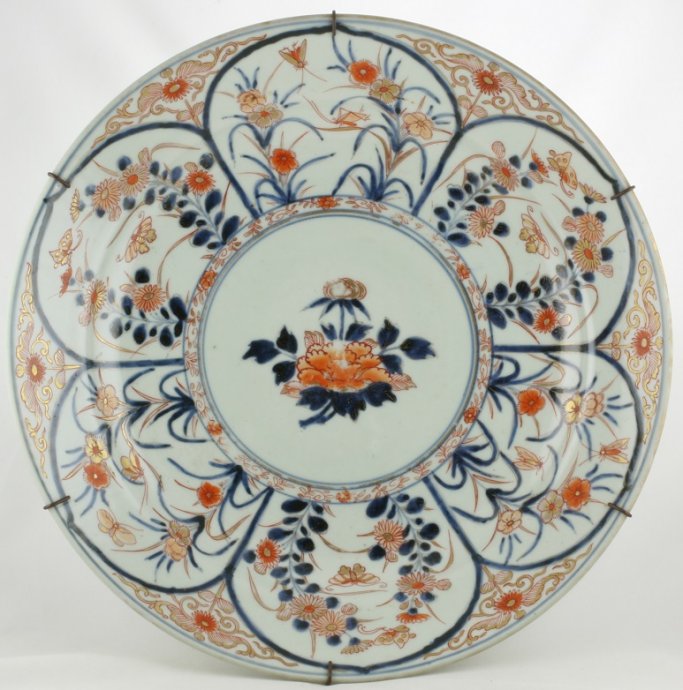
Sold Ceramics - Sold Japanese Imari 1690-1800 - Dishes - Page 1
Object 2011625
Dish
Japan
1710-1720
Height 51 mm (2.01 inch), diameter 367 mm (14.45 inch), diameter of footring 188 mm (7.40 inch), weight 1,739 grams (61.34 ounce (oz.))
Dish on footring, flat rim. On the glazed base six spur-marks. Imari, decorated in underglaze blue, iron-red and gold. In the centre within a band of flower heads and scrolls a flowering peony spray. This is surrounded by six wide lotus-leaf-shaped panels filled with flowering plants and insects On the rim, in between the panels, a flowering chrysanthemum between scrolls. The reverse with chrysanthemum, poppy and prunus sprays. Fitted in a brass frame.
On Japanese ceramics butterflies (Jap.: chõ-chõ; Chin.:hu-tieh) are most frequently pictured in combination with the peony. This composition is of Chinese origin. It not only includes the combination of richness (peony) with happiness (butterfly) but also a rebus. Written with a different ideograph, tieh also means 'double'. The addition of a butterfly to an emblem of good fortune indicates its double effectiveness. (Arts 1983, p.124)
Condition: Some wear to the decoration.
Reference:
Price: Sold.

Sold Ceramics - Sold Japanese Imari 1690-1800 - Dishes - Page 1
Object 2011889
Dish
Japan
1700-1720
Height 41 mm (1.61 inch), diameter of rim 245 mm (9.65 inch), diameter of footring 132 mm (5.02 inch), weight 582 grams (20.53 ounce (oz.))
Dish on footring, straight rim and slightly upturned edge. On the base four spur-marks in a Y-pattern. Imari, decorated in underglaze blue, iron-red and gold with a stylized 16-petal chrysanthemum crest, (kiku no mon). The petals are decorated in gold and iron-red and gold reserved on an underglaze blue ground. Those in gold reserved on an underglaze blue ground show either a lozenge diaper pattern (tasuki) or floral scrolls. Those in red and gold show designs of a flowering chrysanthemum. On the sides two groups of flowering plants, chrysanthemum alternating with peony both growing from rockwork. On the rim flowerheads between scrolls in gold on an underglaze blue ground. The reverse with chrysanthemum, peony and prunus sprays.
Although some types of chrysanthemum begin flowering in the summer, the chrysanthemum is primarily an indication of autumn. Like many autumn motifs the chrysanthemum evokes feelings of melancholy in Japan, as is beautifully expressed in a poem by the 9th-century Ki no Tomonori:
tsuyu nagara / to wear in my hair
arite kazasamu / I plucked a chrysanthemum
kiku no hana / with dew still clinging to it
aisenu aki no / oh may this present
hisashikarubeku / autumn's youth last forever
Despite the chrysanthemum's status as a symbol of the Japanese imperial house, this meaning is only relevant when a 'sixteen'-fold double chrysanthemum', the stylized family crest (mon), is placed prominently and singly on an object.
(source: Fitski 2011, p.149)
For an identically decorated dish, please see:
- Mistrovská dĩla Japonského porcelánu / Masterpieces of Japanese Porcelain, (F. Suchomel, Prague 1997), p.145, cat. 197.
- Imari-Porzellan am Hofe der Kaiserin Maria Theresia, exhibition catalogue (Hetjens-Museum, Düsseldorf, 2000), p.83, cat. 58.
For dishes with a similarly large central chrysanthemum crest, (kiku no mon), please see:
- Porzellan aus China und Japan. Die Porzellangalerie der Landgrafen von Hessen-Kassel, Staatliche Kunstsammlungen Kassel, Berlin 1990, p.518, cat. 286.
- Ko-Imari from the collection of Oliver Impey, (Barry Davies Oriental Art, London, 1997), pp. 200-201, cat. 119.
- Mistrovská dĩla Japonského porcelánu / Masterpieces of Japanese Porcelain, (F. Suchomel, Prague 1997), p.109, cat. 104 & p.128, cat 156.
- Japanese Export Porcelain. Catalogue of the Collection of the Ashmolean Museum, Oxford, (O. Impey, Hotei Publishing, Amsterdam, 2002), p.210, cat. 354.
- Fine & Curious: Japanese Export Porcelain in Dutch Collections, (C.J.A. Jörg, Hotei publishing, Amsterdam, 2003), p.117, cat.126 & p.197, cat. 247 & 247a.
- Complete Catalogue of the Shibata Collection, (The Kyushu Ceramic Museum, Kyushu 2003), p.356, cat. 2789.
For a dish with a similarly large central chrysanthemum crest, (kiku no mon), formerly part of the Dresden collection formed by Friedrich August or August the Strong, Elector of Saxony and King of Poland please see:
Condition: A hairline and a popped bubble of glaze (caused during the firing process) to the rim.
References:
Suchomel 1997, cat. 104, 156 & 197
Jörg 2003/1, cat. 126, 247 & 247a
Price: Sold.
More pictures of object 2012615, another identically shaped and decorated, sold, dish >>

Sold Ceramics - Sold Japanese Imari 1690-1800 - Dishes - Page 1
Object 2010372
Dish
Japan
1700-1720
Height 33 mm (1.30 inch), diameter of rim 255 mm (8.86 inch), diameter of footring 132 mm (5.20 inch)
Dish on footring, flat rim. On the base four spur-marks in an Y-pattern. Imari, decorated in underglaze blue, iron-red and gold with man fishing on a riverbank near a pagoda, trees and two sailing boats, on the left a waterfall with bamboo trees both originating from rockwork, On the horizon a mountain landscape with pagodas trees, clouds and the sun. On the sides and rim rocks from which flowering peony and chrysanthemum plants grow from behind brushwood fences. On the reverse a continuous wide spread flowering prunus scroll.
Condition : Perfect.
Price: Sold.

Sold Ceramics - Sold Japanese Imari 1690-1800 - Dishes - Page 1
Objects 2011565 & 2011566
Pair of dishes
Japan
1680-1700
2011565: Height 33 mm (1.30 inch), diameter of rim 212 mm (8.35 inch), diameter of footring 111 mm (4.37 inch), weight 351 grams (12.38 ounce (oz.))
2011566: Height 33 mm (1.30 inch), diameter of rim 213 mm (8.39 inch), diameter of footring 114 mm (4.49 inch), weight 401 grams (14.15 ounce (oz.))
Two dishes on footrings, slightly everted rims. Imari, decorated in underglaze blue, overglaze iron-red and gold with flowering peony and chrysanthemum plants growing from behind a fence and a single butterfly in flight. On the reverse three flowering prunus sprays. Crackled glaze on both dishes.
The crackled glaze is caused by the unequal contraction of the body and the glaze during cooling in the kiln after firing. (Jörg & Van Campen 1997, p.235)
This specific design was (later) also used in China, for an example of a similarly, in Chinese Imari decorated dish, please see:
Condition:
2011565: A firing tension hairline and a fleabite to the rim.
2011566: Three firing tension hairlines and two unglazed firing flaw spots.
Reference:
Jörg & Van Campen 1997, cat. 267
Price: Sold.
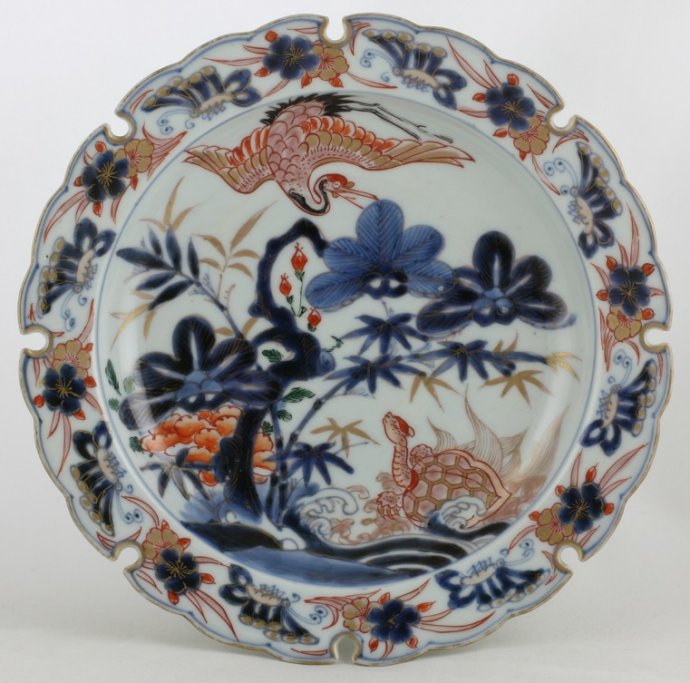
Sold Ceramics / Sold Japanese Imari 1690-1800 - Dishes - Page 1
Object 2012013
Dish
Japan
1730-1750
Height 50 mm (1.97 inch), diameter 244 mm (9.61 inch), diameter of footring 133 mm (5.24 inch), weight 705 grams (24.87 ounce (oz.))
Dish on footring with a spreading flat scalloped rim and eight recesses to the edge. On the base six spur-marks. Imari, decorated in underglaze blue, iron-red and gold with a crane in flight just above a pine tree and various plants growing near a shore with a tortoise rising up from out of the water. On the rim a butterfly alternating with flower sprays. On the reverse three flower sprays.
On Japanese ceramics the tortoise is often depicted in combination with the crane (Q.V.), the design known as tsuru to kame. This combination is emblematic of good fortune and happiness. It refers to a famous legend in which two lovers eventually changed into a crane and tortoise and journeyed together to the realm of the Immortals. The tortoise shell motif is one of the oldest decorative motifs in Japanese art. (Arts 1983, p.118)
The crane (tsuru), the tortoise (minogame), the pine tree (matsu) and the butterfly (chõ-chõ) are all symbols of longevity.
Ten different forms of tortoise are said to exist, the chief of all being the divine tortoise (shin kame), conceived by thought and attaining an age of thousand years or more. At the age of 500 years certain plants would grow upon its shell, which, streaming backwards as it swims about, would give it the well-known appearance of a long-haired tortoise, also known as the 'raincoat' tortoise (minogame), because its resemblance to a peasant's straw raincoat. The Japanese say that the tortoise has inscribed on his back the roku-jõ (six cardinal virtues) namely: chi (wisdom), yú (friendship), gi (fidelity), jin (charity), shin (sincerity) and kan (contemplation), an old idea borrowed from the Chinese. (Arts 1983, p.117)
The shape of this dish is that of a snow flake roundel, (yukiwa-gate). A European influence could very well be possible as the border is not dissimilar to that of Monteith bowls. These dishes come in various sizes and were produced for export most likely by the Higuchi kiln and the Hokaoyama kiln. Usually the Higuchi kiln examples tend to be of poorer quality porcelain than the Hokaoyama examples, but the pattern seems closer to those from the Higuchi kiln. (I am indebted to Mr. T. Coram for this information)
Identical dishes are in the Kyushu Ceramic Museum, the Usui Collection and in an English private collection.
For an identically shaped and decorated (larger 280 mm (11.02 inch)) dish, please see;
One occasionally finds bowls with this form, for an example, please see:
Condition: Some wear to the green enamel.
References:
Price: Sold.
More pictures of object 2012026, another identically, shaped, sized and decorated, sold dish >>


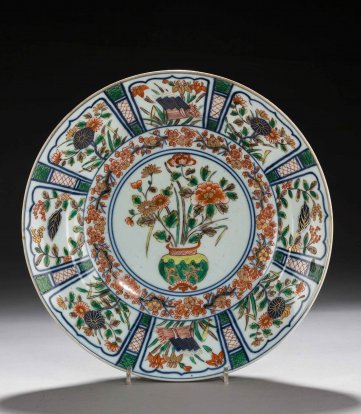
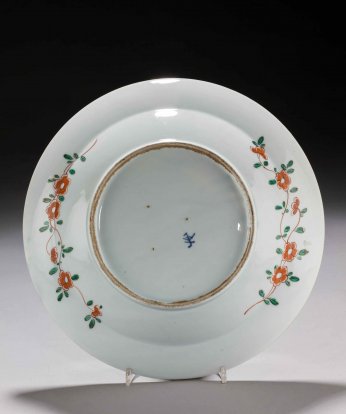


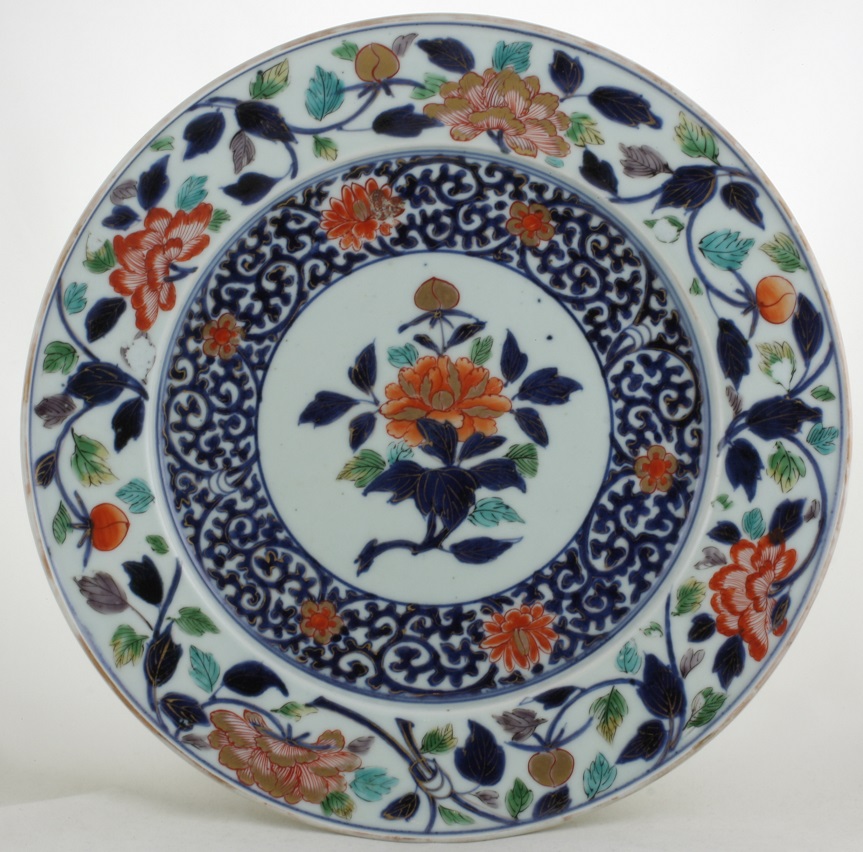
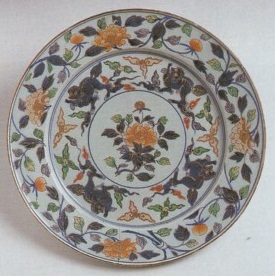
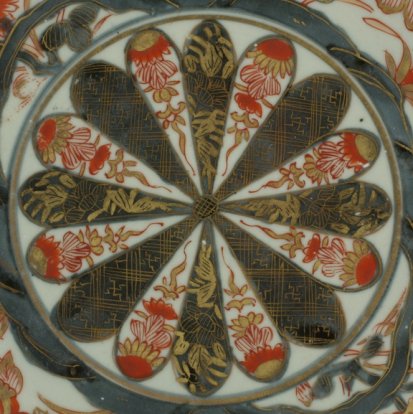
 create websites
create websites